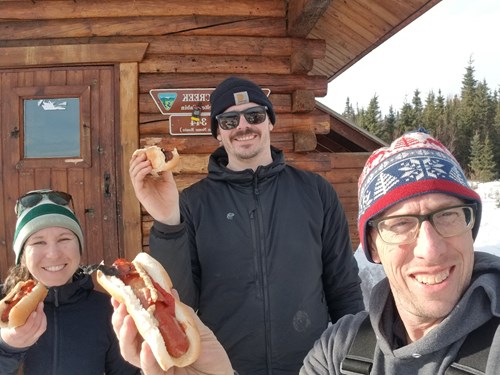12 March 2022

We had a carefully crafted and exciting vision for how our Fresh Eyes on Ice spring traverse from Big Lake to Bethel would go. Allen B, Sarah C, and I (Chris A) created a detailed plan for three weeks of snowmachine travel, ice science, and community engagement with our school monitoring teams in McGrath, Sleetmute, and Bethel. Thanks to physics (weather), biology (COVID), and cultural events (Iron Dog snowmachine race), our actual traverse only made it about one third of the way.
Ideally, we often make decisions based on long-term averages along with personal past experience and general wisdom. We were sweating in nearly 40F weather as we packed our snow machines and sleds in Big Lake, and the weather forecast called for a 5+ day warm outlook. Still, it had to get cold again, right? Traveling over the Iditarod Trail through the Alaska Range in warm temperatures seemed more comfortable than the cold we had anticipated, but how would that play out for the other side of the mountains and downstream travel to Sleetmute and Bethel?
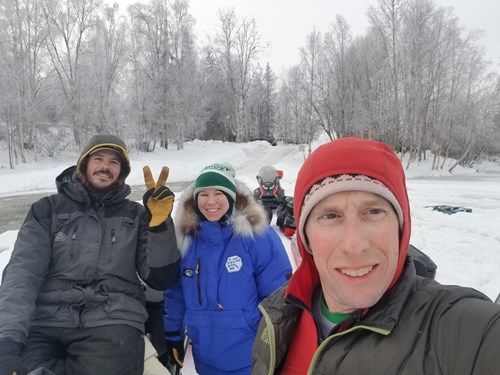
Just two years ago (2020), Allen and I were in Bethel and it was way different than a few days ago when we were supposed to arrive there (see photo of overflow from nearby Napaskiak). The ice road was smooth and long, temps were too cold for even classroom outings, and river travel was easy and abundant. Back then, Covid-19 was also still rather abstract and distant from Alaska with only a very few cases yet observed. Working with Bethel Regional High School students was fun and inspiring.
After a much-abbreviated trip last year down the Tanana R with very socially-distant outreach with Nenana, all seemed set to travel a long gradient of ice conditions down the Kuskokwim R with three CBMTs visits to learn local knowledge and motivate our best Fresh Eyes on Ice (i.e. students, aka young scientists). Leaving after the Iron Dog was a necessity to avoid trail traffic, but we didn’t bank on the resulting trail conditions. How deep warm snow interacts with teams of snogos traveling at 50-100 mph through narrow forested trails wasn’t fully apparent to us in terms of timing our start. Local knowledge we gained from fellow travelers on Day 1 traveling up the Yentna R was key to making good progress on Day 2 of travel, but also might have resulted in our biggest sticking-point later down the trail. Here’s a summary of interacting factors that made for hot zone travel.

Physics: Air temperature in Bethel during our 2022 trip averaged 30F. In 2020, the year we last visited Bethel), it was a cold -2F during the same period. This is compared to long-term average of 15F (1990-2020 from 20-Feb to 8-March). So it was totally warm this year and this on top of a generally larger than normal snowpack, particularly in western AK midlands. Allen told stories of -50F temps in McGrath during the Iditarod (mid-March) only a year or two ago, but we mostly experienced temps near or just above freezing. This was nice for layering up on travel days and camping, but it made travel more hazardous in terms of getting stuck in deep, wet snow. On the few days we had internet access at the beginning of our traverse, we received warnings of more precipitation (including rain) and serious overflow downstream on the Kuskokwim.
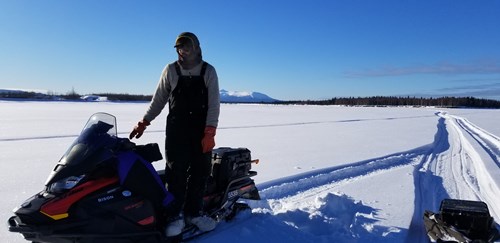
Biology: AK had some of the highest C-19 infections rates in the US just before our departure. Declining rates made us optimistic, but C-19 was still a real concern. We developed a thorough COVID mitigation plan going into this trip to avoid spreading the disease to school monitoring teams we planned to visit, which included 10-day quarantine before departure and a strict testing plan before and after visiting each community on our route. Our thorough planning was put to use on Day 5, when we each took rapid antigen COVID tests in preparation for travel into McGrath. I was initially quite surprised to see my test turn positive. I took a second with the same result. Of course, we didn’t travel that day, let folks know (including McGrath School Principal Matt Shelbourne), and settled in at Bear Creek safety cabin (I moved out to a tent we brought along for just this purpose). Allen joined me in our COVID isolation tent two days later, and finally Sarah tested positive in another two days. After a few days at the safety cabin and lots of inReach texting with Matt, we decided to travel to just outside of McGrath and finish our isolation periods at McGrath School’s new science camp. The science camp was outfitted with two wall tents with nice wood stoves next to a pond, and was a great place, all things considered, to get stuck with COVID. I’m almost positive I know where and when I got infected and I should have been more careful, but it sure was a nice place to stop after the first day of our journey. Travel on that fateful day across the Susitna and up the Yentna R was actually amazing! All kinds of folks were out having fun. It was so nice to see so many people recreating on river ice and enjoying the warm weather. The Iron Dog had just blasted through the day before and lots of folks were out doing their own hot-dogging or just traveling back from one of many cabins along the river.

Culture: Leaving after the Iron Dog was a necessity to avoid trail traffic, but we didn’t bank on the resulting trail conditions. As we bounced and bumped over the trail, it became painfully obvious how deep, warm snow interacts with teams of snowmachiners traveling at 50-100 mph through narrow forested trails. We thought a freshly broken trail might be benefit, but In lots of places the trail was over-broken with high amplitude bumps and deep ruts, especially where forests made the trail tight and mountains made it steep. Local knowledge from Iron Dog trail support crews at Skwentna helped us navigate to Rainy Pass on less degraded paths, but we returned to the bumps and deep trenches once we hit the Farewell Burn on the other side of the mountains. Pulling two sleds each didn’t help much either. I’ll put that in the cultural category too, as we all tend to bring more than is necessary on trips and this can cause problems.
So, this year, we only made it as far as McGrath. Though COVID upended our travel plans, it also helped us make the tough but correct decision not to continue down the Kuskokwim after reaching McGrath. The warm weather and deep snow conditions almost certainly would have spelled trouble for us if we had decided to continue downstream. Getting delayed by COVID actually made our decision to halt our journey in McGrath much easier!
Science and education: We didn’t get nearly as much science done as we had planned. The potential to map and measure ice conditions on the Kuskokwim River from McGrath to Bethel was outstanding, but was not to be this year. We were able to collect a few observations and snow surveys at trails crossing upstream on the South Fork of the Kuskokwim and on a 35-mile stretch of the river centering around McGrath, plus a handful of lakes here and there. Visits to groundtruthing points we identified before departure using optical and SAR satellite imagery (thanks to Dana B!) were much less extensive than we’d hoped.
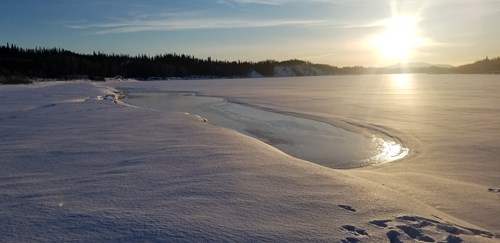
We did get to spend a few days learning from and inspiring ice science with students at McGrath School after each of us completed our COVID isolation periods. First, an all-school assembly and Ice Stories with 3-6th graders (Chris), then more Ice Stories with youngest (K-2) and oldest (7-12th graders) with Allen joining in, then finally a morning of field observations with drones, underwater cameras, and lots of drilling and an afternoon focused on developing science inquiry projects with all three members of the field team with Sarah taking the lead. We are so thankful to McGrath School principal Matt Shelbourne and teachers Carol Simmons and Lindsay Sturm for allowing us to join in their student’s science adventures! The school’s ice science camp at Shooting Range Lake is awesome and such a great resource for McGrath students, plus was the perfect place to complete our COVID isolation before going into classrooms.
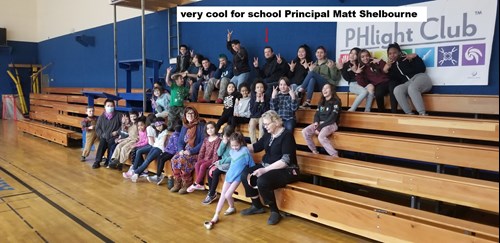
In short, that’s my (Chris’s) story of how physics (weather), biology (covid), and cultural events (Iron Dog race) conspired to impact our Fresh Eyes on Ice traverse in 2022. Our time isolating also gave us a good opportunity to re-evaluate our mode of inter-community, snow machine-based science. Next year we plan to go leaner, maybe earlier (but probably not…as 2022 warmth was hopefully an anomaly), and hopefully avoiding the Iron Doggers, too. We are very grateful to Siri at Polar Field Services for calmly and helpfully responding to our situation and finding us a way back home! Sarah and Allen, I can’t think of two more competent and understanding travel companions to team up with on this recent journey. Riding over hellish bumps and brake-slide down such steep downhills, solving dig-out conundrums, grilling bacon dogs, and spending extra quality time together at various sticking-points were all way better with you two! That’s key to traversing physical, biological, and cultural hot zones.
